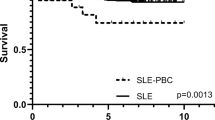Abstract
Our objective was to compare patients with concurrent and sequentially presented systemic lupus erythematosus (SLE)-related protein-losing enteropathy (PLE). Patients with history of SLE admitted for PLE were selected and their clinical, laboratory, endoscopic and imaging characteristics, treatment and outcome were analyzed. From 2001 to 2010, 21 and 27 patients had concurrent and sequentially presented SLE-related PLE, respectively, and their clinical characteristics were comparable except the following: the concurrent group had more pleural effusion (P < 0.01), cutaneous (P < 0.03), neurological (P = 0.02) manifestations, higher creatine phosphokinase (127.6 IU/L vs. 105.7 IU/L, P < 0.05) and lactate dehydrogenase (504.0 IU/L vs. 422.2 IU/L, P < 0.05); whereas the sequential group had higher anti-double strand DNA titer (179.8 vs. 100.4, P < 0.05), 24-h urine protein excretion (1.1 g/d vs. 0.6 g/d, P < 0.05) and increased proteinuria after onset of PLE (0.21 g/d vs. 1.1 g/d, P < 0.04). The endoscopic, histological and radiological features were comparable between the two groups. More patients from the sequential group required more potent immunosuppressive therapy for induction (55.6% vs. 14.3%, P = 0.002) and maintenance (48.2% vs. 9.5%, P < 0.01).The concurrent group associated with better treatment outcomes, with requiring shorter mean time (4.5 months vs. 7.9 months, P = 0.03) for normalbuminemia and more individuals (90.5% vs. 63%, P < 0.02) achieving normalbuminemia in first year. The complications were infrequent: two drug-related adverse events from each group, one patient each from the concurrent group developed shingle and SLE nephropathy. PLE associated with concurrent and sequentially presented of SLE are comparable in clinical behavior; and the immunosuppressive therapy is generally well-responded and tolerated. However, the concurrent group is associated with better disease activity control.
Similar content being viewed by others
References
Aoki T, Noma N, Takajo I et al (2002) Protein-losing gastropathy associated with autoimmune disease: successful treatment with prednisolone. J Gastroenterol 37(3):204–9 (Review)
Mok CC, Ying KY, Mak A et al (2006) Outcome of protein-losing gastroenteropathy in systemic lupus erythematosus treated with prednisolone and azathioprine. Rheumatol (Oxford). 45(4):425–9. [Epub 2005 Oct 18]
Hsu YJ, Lin SH, Lin YF et al (2009) Pitfalls of technetium-99 m-labeled human serum albumin scintigraphy for protein-losing enteropathy. Kidney Int 76(8):911; author reply 911–2
Chen YC, Hwang SJ, Chiu JS et al (2009) Chronic edema from protein-losing enteropathy: scintigraphic diagnosis. Kidney Int 75(10):1124
Tan EM, Cohen AS, Fries JF et al (1982) The 1982 revised criteria for the classification of systemic lupus erythematosus. Arthr Rheum 25:1271–1277
Gladman DD, Goldsmith CH, Urowitz MB et al (1994) Sensitivity to change of 3 systemic lupus erythematosus disease activity indices: international validation. J Rheumatol 21:1468–1471
Al-Mogairen SM (2011) Lupus protein-losing enteropathy (LUPLE): a systematic review. Rheumatol Int 31(8):995–1001. [Epub 2011 Feb 23]
Zheng WJ, Tian XP, Li L, Jing HL et al (2007) Protein-losing enteropathy in systemic lupus erythematosus: analysis of the clinical features of fifteen patients. J Clin Rheumatol 13(6):313–316
Zhu LM, Sun G, Qian JM et al (2011) A clinical analysis of 61 cases of protein-losing enteropathy. Zhonghua Nei Ke Za Zhi 50(3):209–11 (Chinese)
Chau TN, Mok MY, Chan EY et al (2011) Evaluation of Performance of Measurement of Fecal α (1)-Antitrypsin Clearance and technetium-99 m Human Serum Albumin Scintigraphy in Protein-Losing Enteropathy. Digestion 84(3):199–206. [Epub ahead of print]
Wood ML, Foulds IS, French MA (1984) Protein losing enteropathy due to systemic lupus erythematosus. Gut 25(9):1013–1015
Itoi K, Sasaki T, Sawai T et al (1989) Protein-losing gastroenteropathy in association with immune deposits in gastrointestinal mucosal capillaries. Am J Gastroenterol 84(2):187–191
Weiser MM, Andres GA, Brentjens JR et al (1981) Systemic lupus erythematosus and intestinal venulitis. Gastroenterology 81(3):570–579
Gornisiewicz M, Rodriguez M, Smith JK et al (2001) Protein-losing enteropathy in a young African-American woman with abdominal pain, diarrhea and hydronephrosis. Lupus 10(12):835–840
Perednia DA, Curosh NA (1990) Lupus-associated protein-losing enteropathy. Arch Intern Med 150(9):1806–10 (Review)
Marks J, Birkett DA, Shuster S (1972) “Capillary permeability” in patients with collagen vascular diseases. Br Med J 1(5803):782–784
Tsutsumi A, Sugiyama T, Matsumura R et al (1991) Protein losing enteropathy associated with collagen diseases. Ann Rheum Dis 50(3):178–81 (Review)
Fresko I, Hamuryudan V, Demir M et al (2001) Intestinal permeability in Behçet’s syndrome. Ann Rheum Dis 60(1):65–66
Mullin JM, Snock KV (1990) Effect of tumor necrosis factor on epithelial tight junctions and transepithelial permeability. Cancer Res 50(7):2172–2176
Yazici Y, Erkan D, Levine DM et al (2002) Protein-losing enteropathy in systemic lupus erythematosus: report of a severe, persistent case and review of pathophysiology. Lupus 11(2):119–23 (Review)
Conflict of interest
The authors declare there is no conflict of interest.
Author information
Authors and Affiliations
Corresponding author
Rights and permissions
About this article
Cite this article
Law, St., Ma, K.M. & Li, K.K. Clinical characteristics of concurrent and sequentially presented lupus-related protein-losing enteropathy: What are their differences?. Rheumatol Int 33, 85–92 (2013). https://doi.org/10.1007/s00296-011-2356-2
Received:
Accepted:
Published:
Issue Date:
DOI: https://doi.org/10.1007/s00296-011-2356-2




